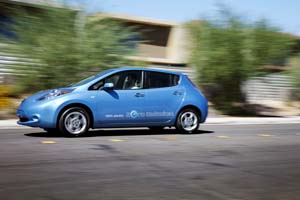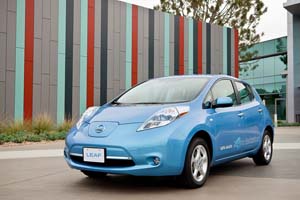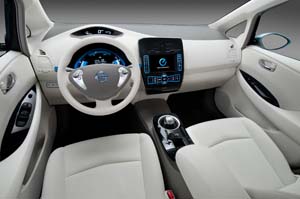 As this year winds down, it’s time to step back and take a look at what happened over the past 10 months. It’s likely that 2011 will be remembered as the year that the electric car was ready for real-world use ? no longer a quirky bleeding-edge technology experiment, but rather a functioning part of the transportation solution. Leading the charge (so to speak) of mainstream electric cars is the 2011 Nissan Leaf.
As this year winds down, it’s time to step back and take a look at what happened over the past 10 months. It’s likely that 2011 will be remembered as the year that the electric car was ready for real-world use ? no longer a quirky bleeding-edge technology experiment, but rather a functioning part of the transportation solution. Leading the charge (so to speak) of mainstream electric cars is the 2011 Nissan Leaf.
The Leaf is affordable ? don?t be intimidated by the $35,440 sticker price. The Leaf qualifies for a $7,500 tax credit on your Federal income taxes, plus a variety of local tax credits depending on where you live. Here in Oregon, the Leaf qualifies for $750 off your personal income taxes if it?s your personal vehicle, plus a free home charging station. If you buy the Leaf for your business, you qualify for a State income tax credit of up to 35% of the vehicle price, with a $7,500 maximum. So most states’ residents get to take somewhere between $8,250 and $15,000 off their tax bills for buying a Leaf. That puts the Leaf solidly into economy price territory.
But the marketplace needs an electric in the family car designation ? and the question on everyone?s mind is how does the Nissan Leaf work in day-to-day use?
 The answer to that question is this: the Leaf works pretty well for everyday family use, but it will still require some changes in your habits. The most obvious thing is that the Leaf has a real-world range of 70-80 miles and then you need to spend several hours charging it up. That could be 4 hours on a 240-volt circuit, or up to 12 hours on a 120-volt connection ? and those 120-volt plug-ins are far more common.
The answer to that question is this: the Leaf works pretty well for everyday family use, but it will still require some changes in your habits. The most obvious thing is that the Leaf has a real-world range of 70-80 miles and then you need to spend several hours charging it up. That could be 4 hours on a 240-volt circuit, or up to 12 hours on a 120-volt connection ? and those 120-volt plug-ins are far more common.
So this means you have an effective range of 80 miles in a day, then you need to spend the night with the Leaf plugged in at your home.
The Leaf SL comes with navigation, backup camera, Bluetooth cell phone support, air conditioning, cruise control, and a nice stereo with satellite radio, AM/FM, and CD player. In short, the Leaf has every single modern convenience.
The interior of the Leaf is nice ? once you learn how to drive the car, it?s all easy. Just keep the key in your pocket and press the button to turn the Leaf on, pull the gear selector over and up for reverse, over and down for forward. Like most electrics, the Leaf has no transmission ? it?s a direct connection between the electric motor and the wheels.
 One more thing to remember ? everything in the car is running off the same battery power. So if you have the headlights on and the wipers on a rainy night (and we have a lot of those in Oregon) and the radio blasting, you?re going to burn through your charge faster than if you?re just cruising along during the daytime.
One more thing to remember ? everything in the car is running off the same battery power. So if you have the headlights on and the wipers on a rainy night (and we have a lot of those in Oregon) and the radio blasting, you?re going to burn through your charge faster than if you?re just cruising along during the daytime.
The Leaf is rated at 99MPGe ? note that little ?e? at the end ? since the Leaf uses no gasoline, you can?t really rate it in conventional MPG. So what the EPA did was to figure how much gas you?d have to burn to generate the electricity to power the car, and figured MPG on that. The exact figures are 106 MPGe in the city, and 92 MPGe on the highway.
Driving the Leaf is fun ? the car is quick off the line, and at least as peppy as any other economy car. It has ample storage space under the hatch, and the rear seats still fold down for carrying larger items.
The bottom line on the Nissan Leaf is this ? if you have a good place to park within about 15 feet of a 120-volt outlet, this car will take care of 95% of your ordinary driving needs without any drama. That last 5%, however, is what will keep a conventional car (or access to a conventional car) in your family driveway. But if you?re a two-car family, making one of those cars a Leaf is a great idea. And that by itself is an historic change in the way we drive.








